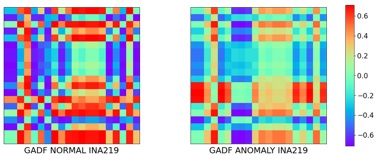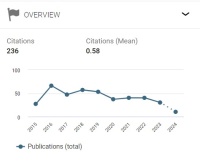Analisis Komputasi Paralel pada Image Encoding Framework untuk Konversi Citra Data Deret Waktu Sistem Kontrol Industri
Abstract
Sensors in industrial control systems send a series of data each time, known as time series data, to the controller. The data contains important information for the controller to determine the control signal for the actuator. The appearance of anomalies in time series data can be detected using the Convolutional Neural Network (CNN) method utilizing image encoding techniques such as Gramian Angular Field (GAF) and Markov Transition Field (MTF). This technique converts time series data into images through data preparation, encoding, and conversion. Dividing extensive data into many smaller segments requires repeated encoding and conversion processes. Repeated processes that are done serially take a long time, which slows down the detection of anomalies and the responses that must be taken. This research applies parallel computation with Joblib and Mpire libraries on the GAF and MTF image encoding provided by the Python-based pyts library. The n_jobs configuration determines the number of CPU logical cores used to execute the program. According to the number of CPU logic cores of the computer, applying the value of n_jobs = 8 can save an average processing time of 63% (Joblib) and 49% (Mpire), which theoretically will be able to detect anomalies that occur at least every 62.73 ms (Joblib) and 86.20 ms (Mpire) compared to 167.51 ms in serial computing.
Downloads
References
[2] D. M. Hawkins, Identification of Outliers. Dordrecht: Springer Netherlands, 1980. doi: 10.1007/978-94-015-3994-4.
[3] A. Blázquez-García, A. Conde, U. Mori, and J. A. Lozano, “A Review on Outlier/Anomaly Detection in Time Series Data,” ACM Comput. Surv., vol. 54, no. 3, pp. 1–33, Apr. 2022, doi: 10.1145/3444690.
[4] C. C. Aggarwal, Outlier Analysis. Cham: Springer International Publishing, 2017. doi: 10.1007/978-3-319-47578-3.
[5] K. Shaukat et al., “A Review of Time-Series Anomaly Detection Techniques: A Step to Future Perspectives,” in Advances in Information and Communication, K. Arai, Ed., in Advances in Intelligent Systems and Computing. Cham: Springer International Publishing, 2021, pp. 865–877. doi: 10.1007/978-3-030-73100-7_60.
[6] G. Pang, C. Shen, L. Cao, and A. V. D. Hengel, “Deep Learning for Anomaly Detection: A Review,” ACM Comput. Surv., vol. 54, no. 2, pp. 1–38, Apr. 2021, doi: 10.1145/3439950.
[7] H. Rahadian, S. Bandong, A. Widyotriatmo, and E. Joelianto, “Open Source OPC UA Data Traffic Characteristic and Anomaly Detection using Image-Encoding based Convolutional Neural Network,” in 2022 7th International Conference on Electric Vehicular Technology (ICEVT), Bali, Indonesia: IEEE, Sep. 2022, pp. 52–59. doi: 10.1109/ICEVT55516.2022.9925002.
[8] S. Oh, S. Oh, T.-W. Um, J. Kim, and Y.-A. Jung, “Methods of Pre-Clustering and Generating Time Series Images for Detecting Anomalies in Electric Power Usage Data,” Electronics, vol. 11, no. 20, p. 3315, Oct. 2022, doi: 10.3390/electronics11203315.
[9] C.-C. Wang and C.-H. Kuo, “Detecting dyeing machine entanglement anomalies by using time series image analysis and deep learning techniques for dyeing-finishing process,” Adv. Eng. Inform., vol. 55, p. 101852, Jan. 2023, doi: 10.1016/j.aei.2022.101852.
[10] G. Liu, Y. Niu, W. Zhao, Y. Duan, and J. Shu, “Data anomaly detection for structural health monitoring using a combination network of GANomaly and CNN,” Smart Struct. Syst., vol. 29, no. 1, pp. 53–62, Jan. 2022, doi: 10.12989/SSS.2022.29.1.053.
[11] H. Y. Yatbaz, E. Ever, and A. Yazici, “Activity Recognition and Anomaly Detection in E-Health Applications Using Color-Coded Representation and Lightweight CNN Architectures,” IEEE Sens. J., vol. 21, no. 13, pp. 14191–14202, Jul. 2021, doi: 10.1109/JSEN.2021.3061458.
[12] J. Faouzi and H. Janati, “pyts: A Python Package for Time Series Classification,” J. Mach. Learn. Res., vol. 21, no. 46, pp. 1–6, 2020.
[13] T. Fu, “A review on time series data mining,” Eng. Appl. Artif. Intell., vol. 24, no. 1, pp. 164–181, Feb. 2011, doi: 10.1016/j.engappai.2010.09.007.
[14] W. Jiang, “Time series classification: nearest neighbor versus deep learning models,” SN Appl. Sci., vol. 2, no. 4, p. 721, Apr. 2020, doi: 10.1007/s42452-020-2506-9.
[15] B. Lindemann, B. Maschler, N. Sahlab, and M. Weyrich, “A survey on anomaly detection for technical systems using LSTM networks,” Comput. Ind., vol. 131, p. 103498, Oct. 2021, doi: 10.1016/j.compind.2021.103498.
[16] I. González, A. J. Calderón, J. Figueiredo, and J. M. C. Sousa, “A Literature Survey on Open Platform Communications (OPC) Applied to Advanced Industrial Environments,” Electronics, vol. 8, no. 5, p. 510, May 2019, doi: 10.3390/electronics8050510.
[17] A. Cartwright, “OPC-UA: the Flow of Data,” Ai Build TechBlog, May 27, 2021. https://medium.com/ai-build-techblog/opc-ua-the-flow-of-data-7c3e5c870a4c (accessed May 21, 2023).
[18] N. Muhlbauer, E. Kirdan, M.-O. Pahl, and G. Carle, “Open-Source OPC UA Security and Scalability,” in 2020 25th IEEE International Conference on Emerging Technologies and Factory Automation (ETFA), Vienna, Austria: IEEE, Sep. 2020, pp. 262–269. doi: 10.1109/ETFA46521.2020.9212091.
[19] Z. Wang and T. Oates, “Imaging time-series to improve classification and imputation,” in Twenty-Fourth International Joint Conference on Artificial Intelligence, 2015.
[20] M. Wang, W. Wang, X. Zhang, and H. H.-C. Iu, “A New Fault Diagnosis of Rolling Bearing Based on Markov Transition Field and CNN,” Entropy, vol. 24, no. 6, p. 751, May 2022, doi: 10.3390/e24060751.
[21] I. A. S. Dewi Paramitha, G. M. A. Sasmita, and I. M. S. Raharja, “Analisis Data Log IDS Snort dengan Algoritma Clustering Fuzzy C-Means,” Maj. Ilm. Teknol. Elektro, vol. 19, no. 1, p. 95, Oct. 2020, doi: 10.24843/MITE.2020.v19i01.P14.
[22] A. Jayadi, T. Susanto, and F. D. Adhinata, “Sistem Kendali Proporsional pada Robot Penghindar Halangan (Avoider) Pioneer P3-DX,” Maj. Ilm. Teknol. Elektro, vol. 20, no. 1, p. 47, Mar. 2021, doi: 10.24843/MITE.2021.v20i01.P05.
[23] Q. Kong, T. Siauw, and A. M. Bayen, Python programming and numerical methods: a guide for engineers and scientists. London: Elsevier, Academic Press, 2021.
[24] “Python Multiprocessing: The Complete Guide,” Super Fast Python, Jun. 26, 2022. https://superfastpython.com/multiprocessing-in-python/ (accessed Feb. 26, 2023).
[25] T. Kim, Y. Cha, B. Shin, and B. Cha, “Survey and Performance Test of Python-based Libraries for Parallel Processing,” in The 9th International Conference on Smart Media and Applications, Jeju Republic of Korea: ACM, Sep. 2020, pp. 154–157. doi: 10.1145/3426020.3426057.
[26] S. Jansen, “MPIRE for Python: MultiProcessing Is Really Easy!,” Medium, Oct. 27, 2021. https://towardsdatascience.com/mpire-for-python-multiprocessing-is-really-easy-d2ae7999a3e9 (accessed Feb. 22, 2023).
[27] “joblib/joblib.” joblib, Feb. 26, 2023. Accessed: Feb. 26, 2023. [Online]. Available: https://github.com/joblib/joblib
[28] “MPIRE (MultiProcessing Is Really Easy).” Slimmer AI, Feb. 20, 2023. Accessed: Feb. 26, 2023. [Online]. Available: https://github.com/Slimmer-AI/mpire


This work is licensed under a Creative Commons Attribution-NonCommercial-NoDerivatives 4.0 International License.

This work is licensed under a Creative Commons Attribution 4.0 International License




